
(Click on any image below for a larger version)
Antarctic Voyage
I recently participated in a cruise to the continent of Antarctica on the MV Hanseatic. The cruise was composed largely of three charter groups; Caltech Alumni and Associates, Smithsonian Institution, and the American Museum of Natural History. It turned out that there were also a few independent people who had booked their cruises directly through Radisson.
Link to the Smithsonian Institute's web page describing the voyage.
Sunday, January 14 - In Transit
Our airplane was a Boeing 767-300. The seating was 2-3-2. It took off on schedule and headed south along the Southern California coast. After a while we could see Baja California below us and the Gulf of California on our left. We flew straight down the spine of Baja and then out over the Pacific Ocean, well to the west of Mexico. The flight to Lima, Peru took over eight hours. The in-flight movie was Chicken Run.
We moved through three time zones on the way to Lima and landed at about 11:00 P.M., local time. We would continue on the same airplane to Santiago. The plane would be on the ground for nearly an hour, so they gave us the option of getting off the plane and going into the airport for a few minutes.
I exited the airplane along with several of the other cruise passengers. We walked down the stairs at the back of the plane and across the tarmac to the airport building. A stewardess handed each of us a "transit" card as we entered the building. We found our way around to the waiting area. There were several gift shops selling Peruvian souvenirs.
Monday, January 15 - Arrival in Buenos Aires
It was early on Monday morning when we were allowed to get back on the plane. It was loaded to capacity again and we took off for the leg of the flight to Santiago, Chile. We crossed two more time zones, landing in Santiago at 6:00 A.M, local time.
We had to change planes in Santiago. It is a much more modern and well-appointed airport than the one at Lima. The waiting area features a small restaurant shaped like a sailing vessel.
The continuing passengers began to look for the waiting area for our next flight. The sign at the information kiosk showed that flight 601 would depart from gate 1. It was quickly apparent that the lowest gate number was gate 10 and people started lining up at the kiosk to ask where to go. A Lan Chile representative approached the sign that indicated the gate numbers and put a 5 next to the 1. We were supposed to be waiting at gate number 15.
The sun rose while we waited for our next flight. Was could see that the airport was surrounded by mountains in most directions. The Andes mountain range was just a short distance away.
We boarded a second Lan Chile 767-300 and took off early in the morning. The airplane climbed out over the rugged Andes. Many of the valleys in the upper reaches of the mountains contained glaciers. The mountains extended out of sight both to the north and south. It took just a half-hour to cross the Andes, and then we were over the Pampas. The land below was divided into ranches and looked very much like the mid-west United States.
We arrived in Buenos Aires about two hours later. Although we had flown nearly due east across the continent, the time did not change between Chile and Argentina. It was 10:00 in the morning when we landed. After we collected our baggage, we were met by a number of porters. They took our bags and loaded them into a truck for the ride to the Caesar Park Hotel.
We gathered in three tour buses for the half-hour ride to the Caesar Park Hotel. The hotel was very nicely appointed. They had snacks, water, and tea waiting for us as we received our room assignments.
Link to the Caesar Park Hotel.
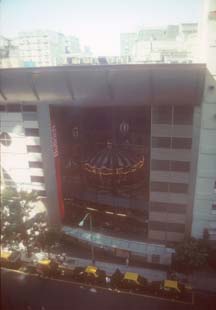 Our room looked out of the front of the hotel.
Across the street was a multi-story restaurant complex with a
carousel on the second floor. Yellow and Black taxis lined up in
front of the complex, waiting to pick up fares. When the driver
at the head of the line departed with a fare, the other drivers
pushed their cabs forward without starting their engines.
Our room looked out of the front of the hotel.
Across the street was a multi-story restaurant complex with a
carousel on the second floor. Yellow and Black taxis lined up in
front of the complex, waiting to pick up fares. When the driver
at the head of the line departed with a fare, the other drivers
pushed their cabs forward without starting their engines.
Tuesday, January 16 - Buenos Aires
After breakfast we were taken on a bus tour of the city. We cruised the streets, going much slower than the general flow of traffic as the hostess pointed out all the monuments and embassies.
The driver parked the bus by the side of a busy avenue, and we were let off to tour the Recoleta Cemetery. It was like a small city in itself.
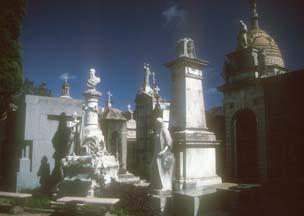 Each plot
had a mausoleum. Each mausoleum had its own distinct style. Some
were made of marble, others of polished dark igneous stone. Some
were sculpted out of concrete. There were many statues of the
departed. Grated doorways and windows allowed a view into the
anterooms. In each anteroom a stairway led down to an underground
crypt.
Each plot
had a mausoleum. Each mausoleum had its own distinct style. Some
were made of marble, others of polished dark igneous stone. Some
were sculpted out of concrete. There were many statues of the
departed. Grated doorways and windows allowed a view into the
anterooms. In each anteroom a stairway led down to an underground
crypt.
We were led through the narrow alleyways between the edifices to the tomb of Eva Peron. One of my favorite monuments was constructed of rough stones that had large ferns growing out of the top and hanging down over the entrance.
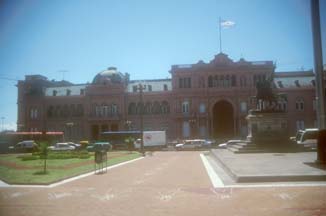 We were taken to the city square
adjacent to the presidential offices, which are housed in the
"Pink House". A tall monument that is emblazoned with
the date of the Creole Revolution of 1810 occupies the center of
the square.
We were taken to the city square
adjacent to the presidential offices, which are housed in the
"Pink House". A tall monument that is emblazoned with
the date of the Creole Revolution of 1810 occupies the center of
the square.
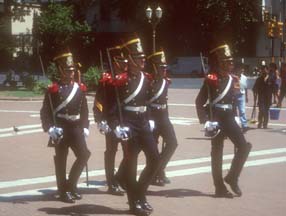 A troop of soldiers in parade dress
marched through the square in slow motion.
A troop of soldiers in parade dress
marched through the square in slow motion.
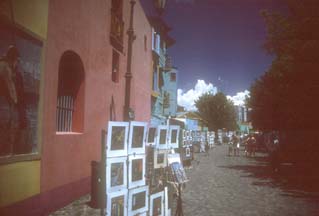 We toured the Boca District. It is
a sort of French Quarter next to the harbor where artists ply
their wares along a cobblestone pedestrian walkway. The houses in
the district are garishly painted with bright colors and complete
disregard for compatibility with the colors on adjacent
structures.
We toured the Boca District. It is
a sort of French Quarter next to the harbor where artists ply
their wares along a cobblestone pedestrian walkway. The houses in
the district are garishly painted with bright colors and complete
disregard for compatibility with the colors on adjacent
structures.
The air temperature and percent humidity were both in the eighties. After a few moments of videotaping, an unfamiliar drop-shaped symbol appeared in the camcorder viewfinder, and it spit out the videotape. It refused to close again. Condensation inside the camcorder had triggered the humidity warning. I had to wait until later in the afternoon for the unit to dry out and begin working again.
I found a shop selling rhodochrosite jewelry and stones inside a mercado. Rhodochrosite is manganese carbonate and looks like pink travertine. The lady behind the counter directed my attention to small, clear, gem-quality pieces mounted in rings and necklaces. I was more interested in a couple of baskets loaded with rhodochrosite spheres. They aren't considered gem-quality, but they have a pretty, lacy, translucent appearance. I bought a couple of the spheres for a fraction of what they cost in Santa Barbara.
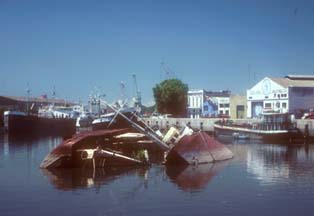 The harbor was just around the corner. There
were several sunken ships lying partially submerged in the slick
brown water.
The harbor was just around the corner. There
were several sunken ships lying partially submerged in the slick
brown water.
The end of the day was occupied with a trip to a local Tango club. After dinner we were treated to a lengthy display of the evolution of the Tango. It began with a moody explanatory performance, all in Spanish, by Aldo. Aldo was the epitome of macho. He had a perfect face to play a mafioso in a Godfather movie. Aldo's monologue was followed by a slow motion, knife fight with another extremely macho character over who got to dance with the pretty tango ladies.
The tango dancers came out dressed at first in costumes appropriate to the late 1800s. The show featured numerous costume changes, reflecting the evolution of style through the last century. The ladies' costumes became scantier with each change.
Our flight was scheduled to depart at 5:30 the next morning. After our return to the Caesar Park Hotel, we packed our bags and placed them outside the room to be collected for the next leg of the journey.
 Table of Contents
Table of Contents  Send
a message to Brian.
Send
a message to Brian.